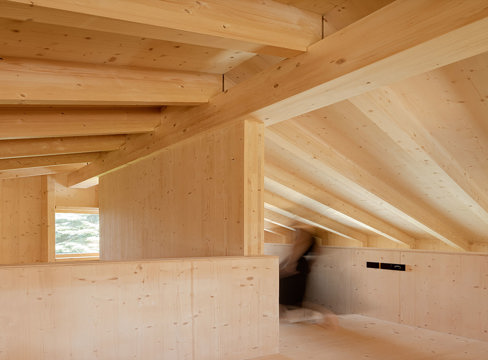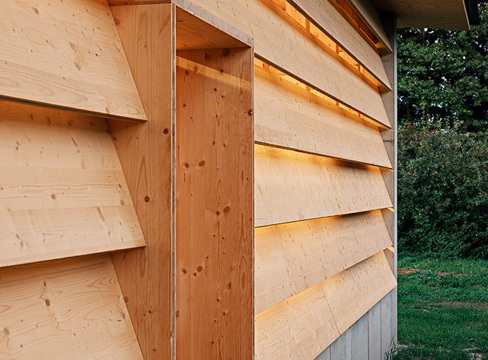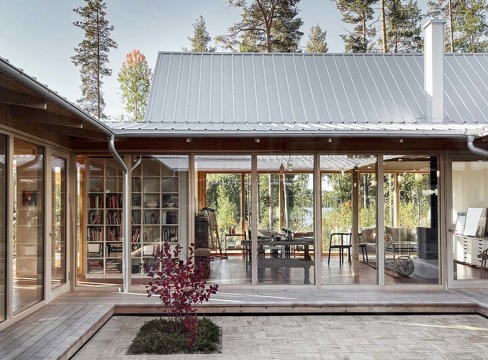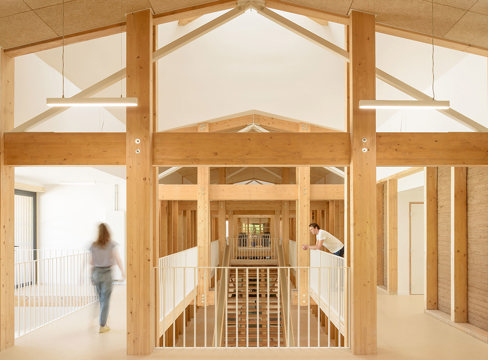When building with wood, it is very common to use products such as chipboard, OSB, plywood, lightweight beams, glulam and cross-laminated timber (CLT). The shared feature of these products is that they all have specific properties for their purpose, with wood and adhesive working together to create a stronger product. Adhesive makes it possible to develop products that allow us to retain wood’s positive properties, such as low weight in relation to its strength, as well as high flexibility and ease of processing. By using adhesive, we can also make more efficient use of our resources, enabling longer spans, stiffer structures and reduced material consumption. The downside is that the different types of adhesives are generally fossil-based, which affects how the wood products can be recycled. Also, several of them emit volatile organic compounds (VOCs), one of which – formaldehyde – has long been recognised as an allergen.
»Adhesives offer the opportunity to create wood products as substitutes for other fossil-based building products. And work is constantly underway to reduce the fossil content of the glue,« says Gabriel Eriksson, technical project manager at Swedish Wood.
The amount of adhesive and the type used are declared, together with a life cycle assessment (LCA) and other information, in the Environmental Product Declaration (EPD). The EPD is supposed to be available on the manufacturer or retailer’s website, but this is not always the case. The absence of an EPD doesn’t mean that the product is bad, but it may be a reason to check it extra carefully, especially for a project with ambitious climate goals.
The table below presents the most common engineered wood products, so more informed choices can be made. The table gives the percentage by weight, but this can be misleading, depending on the choice of material. It is important to base the calculation on the GWP value, which takes into account all the impacts in steps A1–A3 of the LCA. The proportion of glue is slightly higher in lightweight beams than in a glulam beam, but the material use is highly resource efficient. For example, a lightweight beam floor uses a smaller amount of wood raw material.

»It’s important to get EPDs for all the materials in a building, but the total amount of material in a building is the most vital factor in gaining an ultimate understanding of its overall environmental impact,« says Tommy Persson, head of research and development at lightweight beam producer Masonite Beams.
There are four main types of adhesive used in the manufacture of wood products. The adhesive works by reacting with the naturally occurring moisture on the wood surface and cures as the product is compressed, usually in combination with heat. Formaldehyde is a basic constituent of most adhesives.
»For our process, which is based on super fast production, we’ve chosen the adhesive with the lowest formaldehyde content, but this has meant that we’ve had to build larger curing ovens, which require more thermal energy,« says Tommy Persson.
By the time the product is sold, the adhesive has fully cured and will not react further. During production in the factory, systems are in place to manage emissions in accordance with Swedish work environment regulations. The important consideration for the workplace and the end consumer is that the products do not release any emissions into the indoor environment.
To assess whether a product is suitable for use in an interior environment, the emissions from the product are measured and compared with the requirements for construction products and interior products. Emissions in Sweden must not exceed the specified values for E1 as set out in European standard EN 13986. From August 2026, the limit value for formaldehyde emissions in the EU will be reduced to half of the current E1. A commonly used approval mark is the Finnish M1, which is used to indicate the impact of building products, fixed furniture and office furniture on indoor air. An M1 test measures the total amount of volatile organic compounds, formaldehyde and carcinogens in a test chamber over the course of 28 days.
Bio-based adhesives – a priority area of research
Bio-based adhesives are a priority area of research. Most such adhesives have not yet left the laboratory phase, as scientists search for the ideal compromise between bio-based content, performance and price. However, the Swedish forest industry has jointly formulated a promise that its wood products will be completely fossil-free by 2035. This requires the development of fossil-free adhesives, of which there are currently a few examples, including the promising Neoligno from Stora Enso.
Another example comes from Finland’s UPM, which has replaced 50% of the phenol in its spruce plywood with a bio-based product derived from the tree’s own lignin.
There are also challenges in applying the adhesives industrially. Existing adhesives and production methods have been developed, adapted and made more efficient over more than fifty years. Stergios Adamapoulos, Professor of Wood Science at the Swedish University of Agricultural Sciences, is leading the new BioGlue Centre, which aims to help Swedish companies develop bio-based adhesives that work in production.
»Many factors impact on the development of new adhesives. Above all, they need to meet the three criteria of performance, cost and sustainability,« he explains.
The BioGlue Centre initiative currently involves three Swedish universities and 12 companies in the furniture, construction and packaging sectors. The mix of companies and universities is seen as essential for accelerating the development of new products that can be implemented industrially within a decade.













